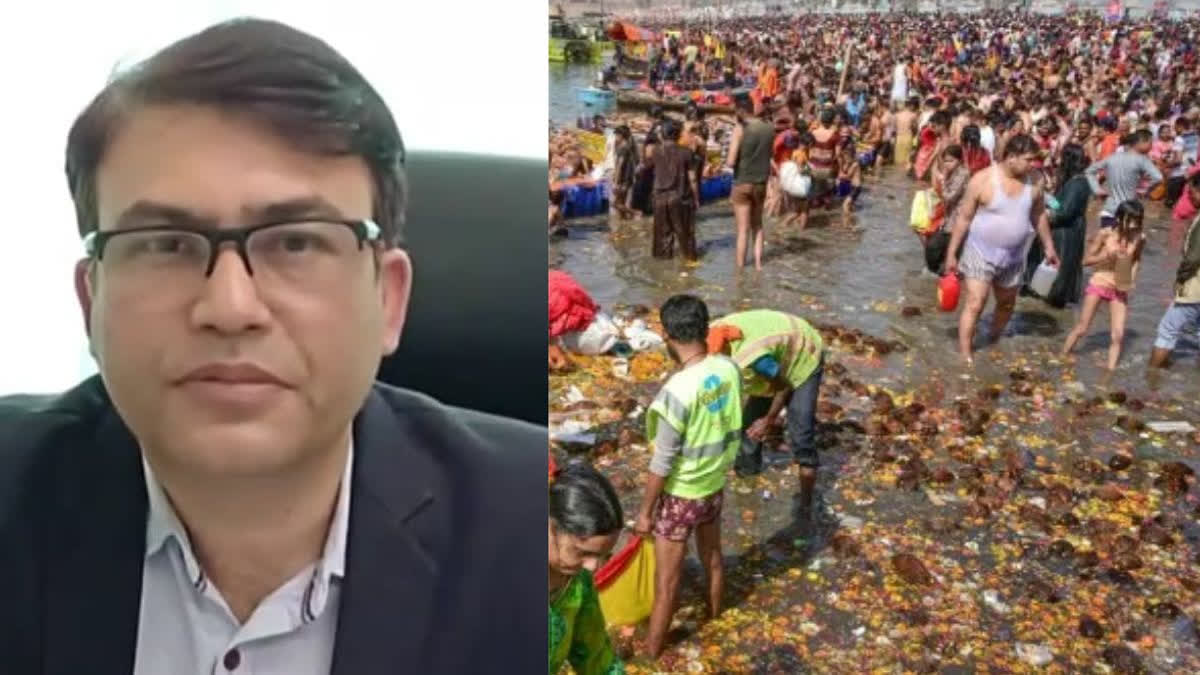Prayagraj: At a time when the Maha Kumbh Mela here is drawing millions of devotees for holy bath at the Sangam, a report from the Central Pollution Control Board (CPCB) questioning the purity of the Gangajal triggered concerns among the visitors. However, environmental scientists from Jawaharlal Nehru University (JNU), Allahabad University (AU), and Bihar University have clarified on the report, stating that the water is absolutely safe for bathing.
The researchers said that the Pollution Control Board's findings are incomplete and there is no mention of elements like nitrate and phosphate in it. They have assured the devotees that the water is clean and safe for bathing. Prior to this, Padma Shri awardee scientist Ajay Sonkar had also rubbished the claims made by CPCB in its report.
In these 40 days of Maha Kumbh Mela, more than 59 crore people have taken a dip in the Sangam. However, the report of the CPCB raised concerns over whether the water is safe enough for bathing. With some people questioning the water's purity, experts jumped in to address the concerns associated with it.
Experts Refute CPCB's Claims
Assistant Professor Dr Amit Kumar Mishra of School of Environmental Sciences, JNU, Professor Umesh Kumar Singh of Centre for Environmental Sciences, AU, and Associate Professor RK Ranjan of Central University of South Bihar argued that the CPCB report lacks important data. "Water in the Sangam is clean. Even on the basis of the current report, Gangajal is alkaline which is a sign of a healthy water body," they assured.
Coliform Bacteria Is Nothing New
Dr Amit Kumar Mishra explained that more data sets are required to back the claims. "Presence of coliform bacteria is nothing new, especially when lakhs of people are bathing together in Maha Kumbh. If you look at the data during Amrit Snan, you will find that E. coli bacteria level is at its peak. We need more parameters and more monitoring stations. Especially downstream, three micrograms per liter of water is safe. At times in Sangam Ghat, it becomes 4 or 4.5. The water's dissolved oxygen levels indicate that it is safe for bathing. If you look at the pH range, it is alkaline water and considerably good," he opined.
Data Is Incomplete, No Mention Of Nitrate-Phosphate
On the quality of water in Triveni, Professor Umesh Kumar Singh of Allahabad University criticised the report of the CPCB which cited increase in fecal coliform (bacteria) in the water. "The CPCB needs to work more on the report. They do not have complete data. The level of nitrate and phosphate is missing. As shown in the report, the level of dissolved oxygen in the water is good. The data itself suggests that the water of Sangam is suitable for bathing," he said.
Too Early To Say Water Is Unsafe For Bathing
Voicing similar opinion, Associate Professor RK Ranjan of South Bihar Central University said the data of Central Pollution Control Board is limited and it would be premature to conclude the purity level of water from this data. "A similar claim has been made about Garhmukteshwar, Ghazipur, Buxar and Patna. A lot of factors are involved. Given that large number of people are taking bath, the timing and place of sample collection can affect the findings," he said.
Know About CPCB Standards
The Central Pollution Control Board of India has set water quality standards for bathing in rivers, specifying the permissible limits fecal coliform and fecal streptococci, pH levels, dissolved oxygen, and other factors. The maximum acceptable limit of fecal coliform is 2500 units per 100 ml. The maximum acceptable limit of fecal streptococci is 2 MPN per 100 ml. The pH recommended range is 6.5 to 8.5; minimum dissolved oxygen level is 5 mg/l. Biochemical oxygen demand maximum acceptable limit is 500 mg/l.
Standards For Correct Water Quality
Electrical conductance (EC) should be less than 750 μS/cm. Chloride concentration should be less than 250 mg/l, Fluoride concentration should be less than 1.0 mg/l, while Sulphate concentration should be less than 400 mg/l.
What Dr Ajay Sonkar's Research Says
Renowned scientist Padma Shri Dr Ajay Sonkar conducted a research on Ganga water samples collected from five different ghats in Prayagraj during the Maha Kumbh. His findings have completely disproved the claims that Ganga water is not suitable for bathing and drinking. He said that the pH levels of Ganga water ranged between 8.4 and 8.6. His reports further showed that no foul smell or bacterial growth was found in the Ganga water. "The water samples were kept at incubation temperature for 14 hours in the laboratory. There was no growth of any harmful bacteria. This in itself proves that Gangajal is safe and suitable for bathing as well as drinking."
Read More
Govt Data: Ganga Water At Sangam Unsafe For Bathing Due To High BOD Levels



